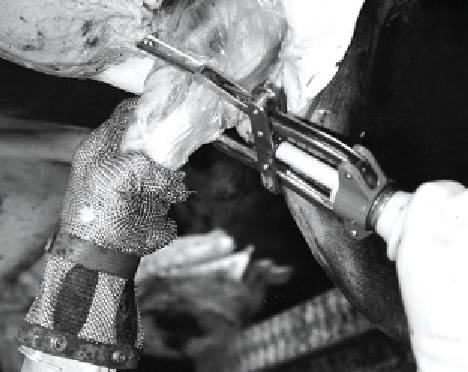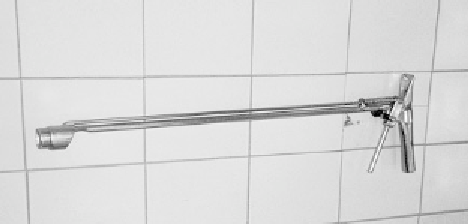Agriculture Reference
In-Depth Information
Cattle
The technique used for sealing the rectum is known
as
bunging
. The system depends to some extent on
skinning technique and on the type of hide-puller
being utilised. If an upwards hide-puller is in use, the
skin is pulled away from the perineal region with the
rest of the hide leaving the perineal region hygieni-
cally exposed. The technique which is recommended
involves the operative placing a plastic bag over his left
hand with a strong elastic band around his wrist. The
exposed end of the rectum is grasped with this hand and
a circular incision made around the rectum, freeing it
from adherent tissues within the pelvis. The plastic bag
is then unfurled over the rectum with the elastic band.
The protected rectum can now be allowed to pass or be
pushed down into the abdominal cavity. If a downward
hide-puller is utilised, the rectum must be freed prior
to removal of the hide. This is a more difficult task to
complete hygienically since the circular cut around the
rectum to free it has to be made through the contami-
nated hide.
Automation of this process has transformed the task
of bung removal, reducing faecal contamination signifi-
cantly, improving carcase dressing technique and mini-
mising operative fatigue and risk of knife damage (to
operative and carcase meat).
A machine developed in Australia known as the Beef
Bung Bagging Machine automatically grasps the rectum,
leaving the operative to clear the rectum from its attach-
ments with a circular incision. A plastic bag and rubber
ring are applied to make a secure seal on the rectum, and
all operations are carried out without hand contact with
the carcase.
A less sophisticated hydraulically operated elastrator
can also be used for sealing a plastic bag with a rubber
ring (Fig. 8.6).
The oesophagus (weasand) in cattle is usually sealed
by an elastrator ring applied at the oesophageal-ruminal
junction in a procedure known as
rodding
. The proce-
dure involves the separation out of the oesophagus and,
using a stainless steel instrument, forcing a rubber ring
up the length of the oesophagus, through the thoracic
cavity, to deposit it using a trigger device at the oesopha-
geal-ruminal junction. Rodding is best carried out
immediately bleeding is completed to prevent the escape
of ruminal fluid, which would contaminate the tissues of
the head and neck (Fig. 8.7).
Sheep
In sheep, after the pelt is removed, the rectum is freed
from the attachments within the pelvis and a length of
30 cm, or more, is exteriorised. Although several
alternative practices exist, it is acceptable to 'milk' the
Figure 8.6
Elastrators with expanded rubber ring ready for plac-
ing over plastic bag or rectum (by courtesy of R. H. S. Moore
MRCVS).
Figure 8.7
Stainless steel rodder.
solid faeces back up the rectum, cut off the posterior few
centimetres and allow the cut end to drop into the
abdominal cavity.
The oesophagus in sheep may be sealed using a
smaller version of the bovine rodding equipment, but
more frequently clips are used.
Pigs
In pigs, the abdominal cavity is opened, and the pubic
synthesis of the pelvis is split prior to the freeing of the
rectum. The anal sphincter is removed intact and, since
the pelvis is split, the rectum can be detached and
removed from the abdominal cavity with the entire
gastrointestinal tract in one movement. Commonly, the
only attempt made to seal the rectum to prevent faecal
spillage is a simple knot tied in the posterior rectum.
The most common reason for contamination of the
carcase is accidental incision of the wall of the rectum
while the operative is cutting round to free it. The pro-
cedure leaves little margin for error since the operative
does not want to cut into the hams, one of the most
expensive cuts.


